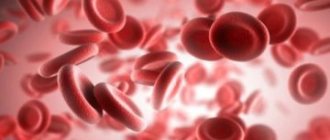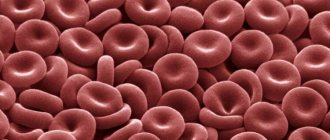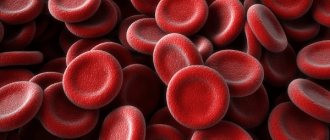Post-transfusion complications
Acute dilatation of the heart
It develops as a result of too rapid or massive entry of canned blood into the patient’s venous bed.
In this case, the right parts of the heart cannot cope with pumping the entire incoming volume, resulting in stagnation of blood in the right atrium and the vena cava system. Symptoms occur during blood transfusion or closer to its end. This post-transfusion complication is clinically manifested by difficulty breathing, cyanosis, pain in the right hypochondrium and in the heart region, decreased blood pressure, increased central venous pressure, tachyarrhythmia, and asystole.
First aid for acute cardiac enlargement is to immediately stop the blood infusion and perform bloodletting in a volume of 200–300 ml to relieve the pulmonary circulation. The patient is provided with a supply of humidified oxygen, the introduction of cardiac glycosides (corglycone, strophanthin), vasoconstrictors (phenylephrine, norepinephrine), and furosemide.
Embolic syndrome
Air embolism is a consequence of air entering first a peripheral vein and then into the pulmonary artery with blockage of its trunk or branches. This complication is entirely related to a violation of the intravenous infusion technique, and for its development it is enough for 2-3 cm3 of air to enter a peripheral vein. Post-transfusion thromboembolism occurs when blood vessels are blocked by blood clots or venous thrombi.
In typical cases, a pulmonary embolism syndrome develops, accompanied by sharp pain in the chest, severe cough, shortness of breath, cyanosis, rapid thready pulse, drop in blood pressure, anxiety and agitation of the patient. With massive pulmonary embolism, the prognosis is usually unfavorable.
When the small branches of the pulmonary artery are blocked by small blood clots, a pulmonary infarction develops, the signs of which are chest pain, cough with bloody sputum, low-grade or febrile body temperature. X-ray data of the lungs correspond to the picture of focal pneumonia.
At the first signs of thromboembolic post-transfusion complications, you should immediately stop the blood infusion, begin oxygen inhalation, thrombolytic therapy (administration of heparin, fibrinolysin, streptokinase), and, if necessary, resuscitation measures. If drug thrombolysis is ineffective, pulmonary embolectomy is indicated.
Citrate and potassium intoxication
Citrate intoxication is caused by both the direct toxic effect of the preservative - sodium citrate (sodium citrate), and a change in the ratio of potassium and calcium ions in the blood. Sodium citrate binds calcium ions, causing hypocalcemia. Usually occurs at high rates of administration of preserved blood. Manifestations of this post-transfusion complication include arterial hypotension, increased central venous pressure, convulsive muscle twitching, and ECG changes (prolongation of the Q-T interval). With a high level of hypocalcemia, the development of clonic seizures, bradycardia, asystole, and apnea is possible. The infusion of 10% calcium gluconate solution can weaken or eliminate citrate intoxication.
Potassium intoxication can occur with the rapid administration of red blood cells or canned blood stored for more than 14 days. In these transfusion media, potassium levels increase significantly. Typical signs of hyperkalemia are lethargy, drowsiness, bradycardia, and arrhythmia. In severe cases, ventricular fibrillation and cardiac arrest may occur. Treatment of potassium intoxication involves intravenous administration of a solution of gluconate or calcium chloride, the abolition of all potassium-containing and potassium-sparing drugs, intravenous infusions of saline, glucose and insulin.
Blood transfusion shock
The cause of this post-transfusion complication is most often the infusion of blood incompatible with AB0 or Rh factor, leading to the development of acute intravascular hemolysis. There are three degrees of transfusion shock: at stage I. systolic blood pressure decreases to 90 mm Hg. Art.; at stage II - up to 80-70 mm Hg. Art.; III Art. - below 70 mm Hg. Art. In the development of post-transfusion complications, periods are distinguished: transfusion shock itself, acute renal failure and convalescence.
The first period begins either during the transfusion or immediately after it and lasts up to several hours. There is short-term excitement, general anxiety, chest and lower back pain, shortness of breath. Circulatory disorders develop (arterial hypotension, tachycardia, cardiac arrhythmia), facial redness, and marbling of the skin. Signs of acute intravascular hemolysis include hepatomegaly, jaundice, hyperbilirubinemia, and hemoglobinuria. Coagulation disorders include increased bleeding and disseminated intravascular coagulation syndrome.
The period of acute renal failure lasts up to 8-15 days and includes the stages of oliguria (anuria), polyuria and restoration of renal function. At the beginning of the second period, there is a decrease in diuresis, a decrease in the relative density of urine, after which urination may stop completely. Biochemical changes in the blood include an increase in the level of urea, residual nitrogen, bilirubin, and plasma potassium. In severe cases, uremia develops, leading to the death of the patient. In a favorable scenario, diuresis and renal function are restored. During the period of convalescence, the functions of other internal organs, water and electrolyte balance and homeostasis are normalized.
At the first signs of transfusion shock, the transfusion should be stopped while maintaining venous access. Infusion therapy with blood replacement, polyion, alkaline solutions (reopolyglucin, food gelatin, sodium bicarbonate) begins immediately. Antishock therapy itself includes the administration of prednisolone, aminophylline, and furosemide. The use of narcotic analgesics and antihistamines is indicated.
At the same time, drug correction of hemostasis, organ dysfunction (heart, respiratory failure), and symptomatic therapy are carried out. To remove the products of acute intravascular hemolysis, plasmapheresis is used. If there is a tendency to develop uremia, hemodialysis is required.
Safety of blood and its components
— Cases of hepatitis and HIV infection as a result of blood transfusion are increasingly being discussed in the media. How acute is this problem today and are any measures being taken to ensure safety during blood transfusions in Russia?
“Indeed, several cases of infection with incurable diseases have caused a wide resonance thanks to the efforts of journalists. But the number of facts that have not received publicity is much greater. In 2005, according to the board of the Ministry of Health and Social Development of the Russian Federation, about 1,400 cases of infection with hepatitis B, 3,500 with hepatitis C, and 12 with HIV were registered, but these figures can be safely multiplied by at least ten. Today in our country there are thousands of people who have become infected with HIV, viral hepatitis, cytomegalovirus infection and other diseases as a result of blood transfusions, and many of them do not yet suspect that they have the disease. Accurate official statistics on the spread of infections by this route in Russia are not yet available, but for a rough estimate you can use the data of foreign colleagues. It is known that during the period 1980-90s, about 300 thousand people were infected with the hepatitis C virus through blood transfusion in the USA, about 16 thousand in Canada, about 100 thousand in France. It is reasonable to assume that in our country these figures there were even more.
We can briefly list the basic principles that ensure blood safety: the creation of a permanent donor base, leukofiltration, quarantine or antiviral treatment, microfiltration, which frees blood from microclots. Let's see how they are implemented around the world and in Russia.
Today, in Europe and America, a set of measures is being taken to ensure high safety during blood transfusion, and the number of cases of infection transmission through this route has rapidly fallen. For example, in France several years ago, a large number of patients were infected with hepatitis C and HIV through blood transfusion, which attracted the attention of the public and government. A year after this, as a result of measures taken at the state level, the entire system of collecting donor blood was revised and blood transfusion in this country became one of the safest in the world. There, for example, 100% of transfused blood and its components undergo leukofiltration. Today, 1 case of hepatitis C transmission occurs in France per 500 thousand blood transfusions. In the USA, this figure is already 1 in 300 thousand, since in this country only 90% of donor blood undergoes leukofiltration. As you can see, the relationship between the percentage of blood filtered and the risk of infection is very strict. If you look at statistics from developed countries, it turns out that the proportion of donor blood that undergoes leukofiltration ranges from 90 to 100%.
A completely different picture is observed here. If we take only one indicator—leukofiltration—then today only 10% of all donor blood undergoes it. No more than 15% are subject to quarantine. A significant proportion of all blood transfused comes from random donors who donate blood on an irregular basis. A very large part of blood components entering medical institutions passes through resellers who do not care about observing the rules of storage and transportation, and as a result they reach the patient in virtually spoiled form. Finally, in our country there is not yet a single enterprise for the antiviral treatment of donor blood. We can draw a sad conclusion: at the moment, not a single Russian is immune from infection through transfusion of blood and its components.
— You are the Chairman of the Board of Trustees of the Blood Service to People Foundation. Tell our readers about his activities.
— “Blood Service for the People” is an independent charitable foundation organized under the patronage of the Russian Academy of Medical Sciences and the Main Directorate of Special Programs of the President of the Russian Federation in 1998. Our task is to ensure safety during transfusion of blood and its components to patients. Oddly enough, the very concept of “safety” did not exist in donation laws for a long time. The responsibility of blood transfusion stations and departments was limited to the procurement of the required quantity, processing, storage and transportation of blood and its components. At the same time, the recipient who received the blood was not protected by law from possible infection with deadly diseases. But today every schoolchild knows that incurable diseases are transmitted through blood! As a result of the activities of the foundation, the Ministry of Health and Social Development of the Russian Federation and the Russian Academy of Medical Sciences, it was possible to create a number of documents regulating the safety of blood transfusion in our country.
From 2000 to 2003, a number of important orders of the Ministry of Health of the Russian Federation were adopted concerning compliance with the basic principles of blood transfusion safety, which I listed above. Orders of the Ministry of Health of the Russian Federation No. 311 (dated 08/04/2000) “On measures to improve the safety of blood transfusions”, No. 244/63 (dated 07/03/2001) “On the introduction into the work of blood service institutions of devices for removing leukocytes from donor blood”, No. 363 ( dated November 25, 2002) “On approval of the Instructions for the use of blood components” relate to leukofiltration of donor blood. Order No. 193 (dated 05/07/2003) “On the introduction into practice of the blood service in the Russian Federation of the method of quarantine of fresh frozen plasma” formulates the correct method for obtaining safe blood plasma. These orders are addressed primarily to the heads of healthcare authorities in the constituent entities of the Russian Federation and their implementation must be monitored locally.
Finally, at the end of December 2006, Law No. 258-FZ “On Amendments to Certain Legislative Acts of the Russian Federation in Connection with Improving the Separation of Powers” was adopted. This law is very important for us, as it contains an amendment to the Law of the Russian Federation “On the Donation of Blood and Its Components,” which regulates the safety of transfused blood.
So, according to the current legislation of the Russian Federation, at all points involved in the collection and preparation of donor blood, measures must be taken to ensure its safety. These are, in particular, plasma quarantine and leukofiltration.
— More than a year has passed since the law was adopted, and the statistics that you cited at the beginning of our conversation look disappointing. Does this mean that the law is not being implemented?
— Yes, and the Ministry of Health and Social Development of the Russian Federation or the Russian Academy of Medical Sciences cannot be blamed for this. Responsibility for failure to comply with the law lies with specific heads of regional health departments, chief doctors and heads of blood transfusion departments. Donated blood does not undergo measures to ensure its safety, and this is legally a crime. Of course, in order to ensure quarantine of plasma and purchase the necessary leukofiltration systems for the transfusion station, certain funds are needed. But practice shows that such funds can be obtained if you raise this question and monitor its resolution. High-quality leukofiltration systems, for example, are produced in our country, and there is no need to purchase expensive imported leukofilters for these purposes. In fact, the safety of blood components collected in different regions and even regions varies greatly. Thus, the health departments of Yekaterinburg, Lipetsk, and Kursk have achieved good control over the safety of blood transfusion at their blood transfusion stations. Excellent indicators were registered in FSB hospitals, which carry out leukofiltration and quarantine of 100% of collected blood and its components. At the same time, in the Moscow, Tula, Voronezh regions and even in such a large center as St. Petersburg, leukofiltration is still practically not carried out, which means that people continue to be infected with incurable diseases.
— What is the risk for a person who is transfused with blood that has not undergone appropriate treatment?
— Together with donated blood, dangerous and often incurable diseases can be transmitted. The most famous of them are hepatitis C and B, AIDS, syphilis. These four diseases, about which a lot is spoken and written today, are the main ones for the presence of pathogens that are analyzed in donor blood in all countries of the world. In Switzerland, cytomegalovirus (CMV) infection has been added to this list. CMV is a very insidious virus, especially dangerous for pregnant women, as it can cause severe developmental disorders of the fetus and congenital deformities. In addition, many other infections are transmitted through blood: T-cell lymphoma virus, Epstein-Barr virus, recently discovered prion proteins, various herpes viruses, a total of 29 known pathogens of human diseases.
There are categories of patients who require regular transfusions of blood components, these include, for example, children suffering from hemophilia. These people are especially at risk. According to the same board of the Ministry of Health and Social Development of the Russian Federation, up to 80-90% of patients with hemophilia become infected with viral infections through components of donor blood in the first year of treatment for the underlying disease. We should not forget that not only recipients, but also doctors and nurses who work with donor blood components every day are at increased risk.
When transfusing blood and its components, the danger is posed not only by the presence of pathogens, but also by formations such as microscopic clots and aggregates. They are formed during storage and transportation of blood components, especially if leukofiltration has not been performed before. Once in the recipient's bloodstream, they can cause severe reactions: severe fever, embolism, and even death. To free the transfused blood from such clots, microfiltration must be used.
— Let's briefly look at each of the principles of ensuring the safety of donor blood. What is the importance of regular donation and quarantine?
— First of all, it is necessary to revive the institution of regular donation. We all know that in the Soviet Union there was a fairly developed system of blood procurement. As a rule, highly moral, responsible people became donors, mainly for altruistic reasons, and not for the purpose of making a profit. This entire system collapsed along with the socialist system and the transition to a market economy. Today, despite the large number of social advertising and various charitable events, the majority of donors are interested in the required monetary reward. You can imagine who is trying to make money in this way: among them there are many antisocial elements, the unemployed, even drug addicts! These people are often carriers of blood-borne infections, and in most cases they do not even know about their disease.
We will not dwell in detail on the issue of shortage of donor blood - this is a topic for a separate discussion. Suffice it to say that today there is a catastrophic shortage of it, and, unfortunately, even clearly disadvantaged donors are allowed to donate blood. At many blood collection points, doctors do not pay attention to marks from injections on a person’s hands or to his appearance. But even the presence of an ordinary tattoo on the body can serve as sufficient grounds for refusing to take blood from a potential donor.
Under these conditions, all plasma collected at stations and in transfusion departments must undergo quarantine. The fact is that a negative test for viral infections made at the time of blood collection from a donor does not guarantee the absence of pathogens of these diseases in the blood. Antibodies, based on the presence of which such an analysis is carried out, do not appear in a person’s blood immediately: it may take six months before they are formed in sufficient quantities. The donor who donated blood must return after 6 months for a repeat test. All this time, his plasma, which can be stored in a refrigerator for a long time, is in quarantine, and only after confirmation of the analysis can it be used for transfusion to recipients. Unfortunately, this rule is not always followed in our country. Many irregular donors, having donated blood and received a reward, simply disappear. The blood plasma obtained from them is often illegally sold at a lower price and, after passing through resellers, ends up in a medical institution.
— What about leukofiltration?
— Leucofiltration, or leukoreduction, is an internationally recognized method of increasing the safety of transfused blood. Its essence lies in the fact that leukocytes are removed from donor blood using a special filter. Pathogens, as a rule, do not float in the blood freely - they are fixed on its cellular components, leukocytes, or located inside them, which means they can be removed by filtration. The filter consists of a fibrous substance with a certain pore diameter that retains white blood cells, but allows smaller platelets and red blood cells to pass through. Of course, each leukofiltration system used must have a quality guarantee. Transfusion of leukocyte-free blood plasma, red blood cells or platelets into the recipient reduces the risk of contracting certain diseases by hundreds and thousands of times. And if a small amount of HIV and hepatitis viruses can still penetrate the filter, then pathogens such as herpes viruses and CMV are filtered out 100%. In Switzerland, for example, it is allowed to transfuse patients with leukofiltrated blood from CMV-positive donors.
Leukofiltration should be carried out in transfusion departments immediately after blood collection from a donor. Later, white blood cells may be destroyed and pathogens will be released into a fraction of small particles that cannot be filtered out. According to the amendment to the law on donation, all departments in which blood is collected from donors must be equipped with leukofiltration devices and filters.
I would like to add a few words about automatic blood sampling systems. A fairly large number of blood transfusion departments in Russia are equipped with such systems, and many mistakenly believe that “automatic machines” provide a sufficient level of safety. This is not true. Donor blood and its components obtained using automatic systems do not meet accepted international safety standards, according to which the residual number of leukocytes should be no more than 1x106 per dose. On average, blood and its components prepared using the hardware method contain 1108-9 leukocytes per dose. And this must be remembered.
— How accessible are leukofiltration systems in our country?
— Some managers responsible for the equipment of blood transfusion stations justify failure to comply with safety requirements for economic reasons. Such justifications are devoid of sufficient grounds: in fact, leukofiltration systems are quite accessible and can be purchased in any department.
Many blood transfusion stations use foreign filtration devices, which are indeed quite expensive. But high quality leukofilters are produced today in our country. Imported raw materials and technologies are used, which ensures that the produced filters comply with high safety standards: a sterile disposable filter with a filtration coefficient of 99.97% guarantees a residual number of leukocytes of no more than 1x106 per dose. At the same time, the production and assembly itself is carried out in Russia, in the Moscow region, so the price of the filters is relatively low. When passing through the filter, red blood cells and platelets do not change their functional and morphological properties, and the resulting purified mass can be stored for the same amount of time as one that has not undergone filtration. These filters have been tested in practice in many large clinics in Russia, including the Hematological Research Center of the Russian Academy of Medical Sciences.
How many filters should I purchase? Approximately this figure can be estimated from the calculation: 1 filter per 1 blood draw from one donor. Thus, one enterprise can easily provide filters to all blood transfusion departments in our country. Filters for microfiltration are also produced, which free transfused blood from micro- and macro- (more than 30 microns in diameter) clots, devices for blood transfusion with simultaneous filtration, and other necessary equipment. Transfusion of blood and its components should only be carried out through a device equipped with a microfilter. This condition must be met without fail.
— What measures to ensure safe blood transfusions, in your opinion, can be taken in the future?
“Attracting healthy, conscientious donors would help solve the problem of blood shortage that exists in our country. However, a more effective way out of this situation would be to create a blood bank. Indeed, no person is immune from the occurrence of a critical situation when an urgent transfusion of blood components is required. An accident, injury, surgery, difficult childbirth - all these cases may require blood transfusion. At the same time, modern technologies make it possible to store the red blood component and plasma frozen for several years - up to twenty. A blood bank would allow anyone to donate some of their own blood in case an emergency transfusion is needed for the person or a close relative. This system has already been used, for example, during the war, and has proven to be very effective. Thus, many American soldiers who fought in Vietnam were saved due to the fact that their autologous and donor blood and its components were stored at the nearest base and were ready for transfusion at the moment when it was required. Today, many countries around the world have autologous blood banks, while in Russia there are still no such banks.
Returning to the topic of our conversation today, I would like to once again emphasize one point. Now in Russia there are all the necessary prerequisites for ensuring blood safety: there are material possibilities for leukofiltration, microfiltration and quarantine of blood components, a legislative framework has been developed regulating measures to protect recipients from infection. What happens next depends mainly on the actions of local leaders. Every chief physician of a blood transfusion station, head of a blood transfusion department, every official in the local health department must realize the seriousness of the problem and responsibly comply with the laws.
It must be remembered that punishment for violating these laws may restore justice to some extent, but will not restore lost health to a person who suffered due to someone’s criminal negligence. When such a responsible approach to the problem of blood safety is practiced in our country, then (and only then) blood transfusion can become practically safe. And let this happen not next year, as in France, but at least over several years, gradually.
Remember, once upon a time the widespread introduction of safe disposable syringes seemed unattainable, but today they are used in any medical institution. The use of leukofiltration, quarantine, microfiltration and other measures to ensure blood safety should become equally commonplace in our medical practice.
Interviewed by Ekaterina IVANOVA











